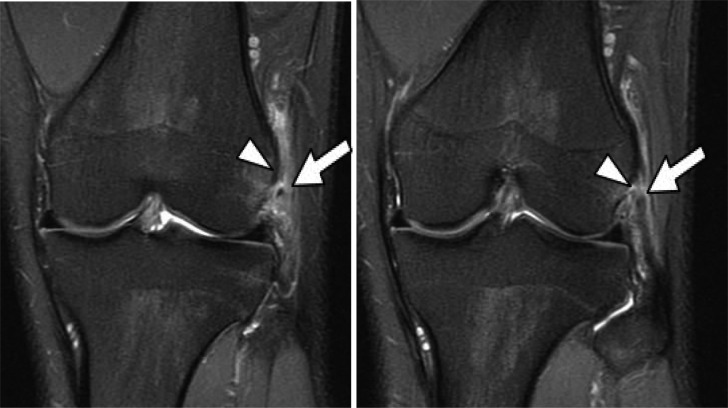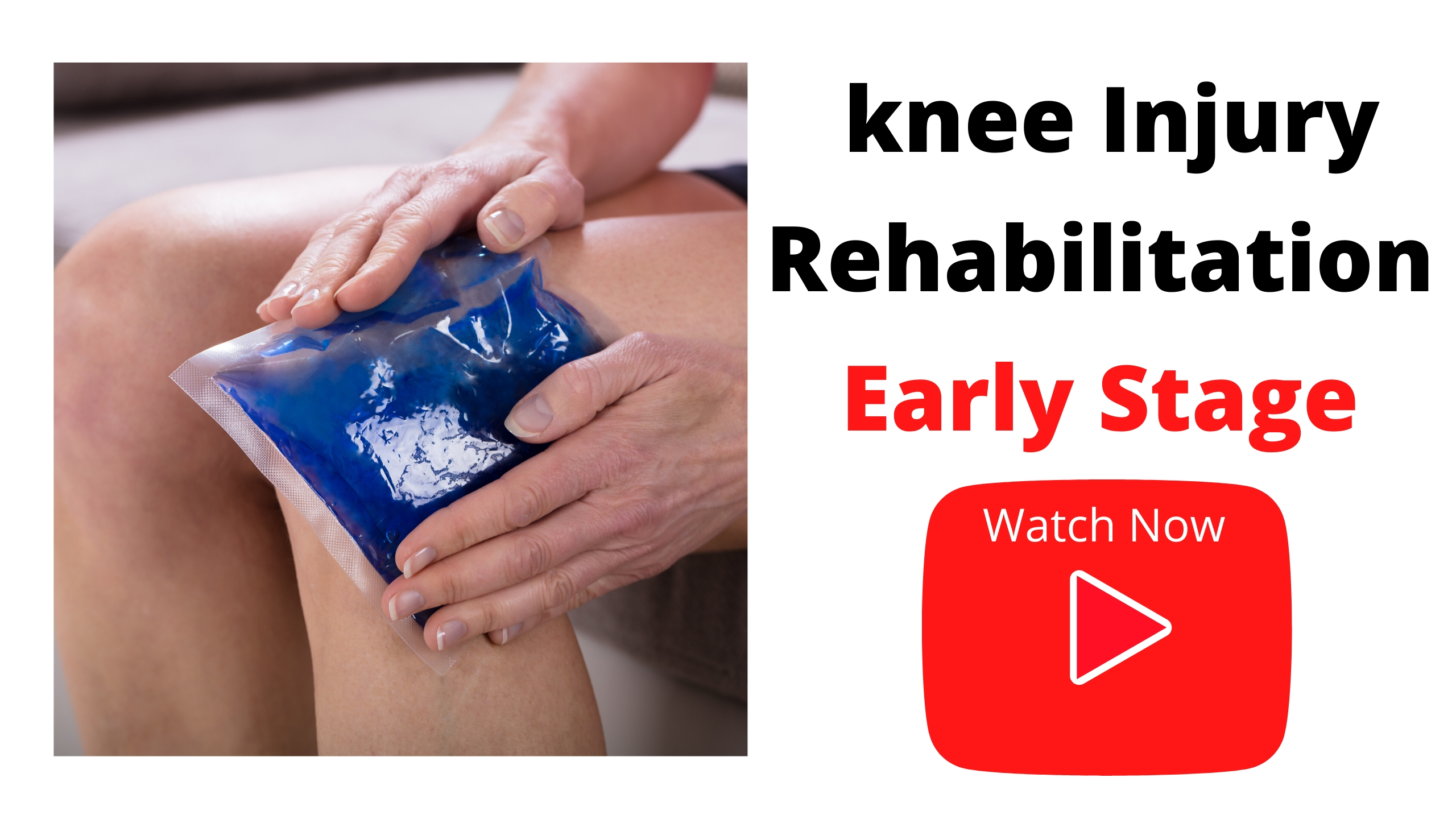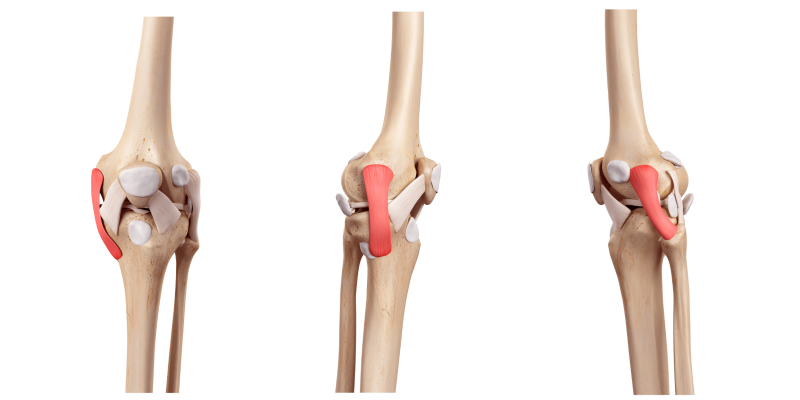Your lateral collateral ligament (LCL) is a cord-like ligament on the lateral (outer) side of your knee. It is one of four major ligaments that help you to stabilize the knee joint. LCL sprain is the most common form of LCL injury. In isolation, a lateral collateral ligament injuries only account for 2% of all knee ligament injuries. Most LCL injuries occur in combination with, damage to other knee ligaments and structures for instance ACL, or the combination with the LCL with the meniscus.
 Picture Source: LCL
Cause of LCL Sprain?
The main function of your lateral collateral ligament is to resist varus force and external tibial (shin bone) rotation, which occurs if your tibia/foot is forced inwards in relation to the knee or when your foot is grounded and your knee is twisted medially.
The LCL is injured when the varus force is too great for the ligament to resist and the ligament is overstretched. This can occur through a sharp change in direction, twisting the knee whilst the foot is fixed, incorrect landing technique, hyperextension of the knee or a blunt force hit to the knee, such as in football tackle or a motor vehicle accident.
Picture Source: LCL
Cause of LCL Sprain?
The main function of your lateral collateral ligament is to resist varus force and external tibial (shin bone) rotation, which occurs if your tibia/foot is forced inwards in relation to the knee or when your foot is grounded and your knee is twisted medially.
The LCL is injured when the varus force is too great for the ligament to resist and the ligament is overstretched. This can occur through a sharp change in direction, twisting the knee whilst the foot is fixed, incorrect landing technique, hyperextension of the knee or a blunt force hit to the knee, such as in football tackle or a motor vehicle accident.

 Knee injury rehabilitation the mid stage.
Knee injury rehabilitation the mid stage.

 Picture Source: LCL
Cause of LCL Sprain?
The main function of your lateral collateral ligament is to resist varus force and external tibial (shin bone) rotation, which occurs if your tibia/foot is forced inwards in relation to the knee or when your foot is grounded and your knee is twisted medially.
The LCL is injured when the varus force is too great for the ligament to resist and the ligament is overstretched. This can occur through a sharp change in direction, twisting the knee whilst the foot is fixed, incorrect landing technique, hyperextension of the knee or a blunt force hit to the knee, such as in football tackle or a motor vehicle accident.
Picture Source: LCL
Cause of LCL Sprain?
The main function of your lateral collateral ligament is to resist varus force and external tibial (shin bone) rotation, which occurs if your tibia/foot is forced inwards in relation to the knee or when your foot is grounded and your knee is twisted medially.
The LCL is injured when the varus force is too great for the ligament to resist and the ligament is overstretched. This can occur through a sharp change in direction, twisting the knee whilst the foot is fixed, incorrect landing technique, hyperextension of the knee or a blunt force hit to the knee, such as in football tackle or a motor vehicle accident.
Risk factors of LCL tears
While anyone can injure their lateral collateral ligament, participation in certain sports puts people at higher risk. People who frequently participate in contact and non-contact sports that involve tackling, cutting, pivoting, or jumping are more likely to sustain an LCL injury. These sports include but are not limited to football, hockey, soccer, and skiing.Grades of ligament Sprain
The severity and symptoms of a knee ligament sprain depend on the degree of stretching or tearing of the knee ligament.1st Grade
In a mild Grade I LCL sprain, the knee ligament has a slight stretch, but they don’t actually tear. Although the knee joint may not hurt or swell very much, a mild ligament sprain can increase the risk of a repeat injury.2nd Grade
With a moderate Grade II LCL sprain, the knee ligament tears partially. Knee swelling and bruising are common, and the use of the knee joint is usually painful and difficult. You may have some complaints of instability or a feeling of the knee giving way.3rd Grade
With a severe Grade III sprain, the ligament tears completely, causing swelling and sometimes bleeding under the skin. As a result, the joint is unstable and can be difficult to bear weight. You may have a feeling of the knee giving way. Often there will be no pain or severe pain that subsides quickly following a grade 3 tear as all of the pain fibers are torn at the time of injury. With these more severe tears, other structures are at risk of injury including the meniscus and/or ACL.How Long does it take for an LCL Injury to Heal?
Treatment of an LCL injury varies depending on its severity and whether there are other combination injuries. G1: Grade I sprains usually heal within a few weeks. Maximal ligament strength will occur after six weeks when the collagen fibers have matured. Active recovery with minimizing the painful activity, icing the injury, and some anti-inflammatory medications are useful. Your Physical therapist could prescribe an exercise routine to follow and a guideline regarding strengthening exercises to strengthen your knees which will help to prevent a future tear. G2: When a Grade II sprain occurs, the use of a weight-bearing brace or some supportive taping is common in early treatment. This helps to ease the pain and avoid stretching the healing knee ligament. After a grade II injury, you can usually return to activity once the joint is stable and you are no longer having pain. This may take up to six weeks. G3: When a Grade III injury occurs, you usually wear a hinged knee brace for up to six weeks, with a small amount of movement, and use crutches for 1-2 weeks to protect the knee ligament from weight-bearing stresses. As your pain resolves and knee ligament repairing occurs, the knee brace can be gradually unlocked to allow greater knee movement as tolerated. The aim is to allow for full knee ligament healing and gradually return to normal activities. Severe LCL injury is most successfully treated via physical therapy and the advice of a knee surgeon. Patients may not return to their full level of activity for 3 to 4 months.Treatment for an LCL Injury?
Depending on the severity of your injury you can start to feel better within days to just a few weeks of the injury. Your acute phase of treatment will aim to follow the POLICE protocol and avoid any HARM. We suggest that you discuss your knee ligament injury rehabilitation plan after a thorough examination by a physical therapist / Physiotherapist who is familiar with sports injuries. Most LCL injuries resolve well with conservative management, however, surgery may be considered if there is significant ligament disruption eg Grade III. Knee surgery may also be required if there is a significant combination of injuries involving the ACL, posterolateral corner and/or meniscus.FOLLOW US ON YOUTUBE AND GET ACCESS TO OUR WEEKLY FREE REHABILITATION EXERCISES.

Rehabilitation / Exercise program
The rehabilitation program will be customized for every individual and it could take between 8 to 15 weeks depending on the severity of the injury. Your exercise goals initially focused on normalizing gait, developing strength around the knee and neuromuscular control in the sagittal plane, proprioceptive activities, and progression to sports-specific training. After gaining good control in the sagittal plane, we will progress you to the frontal plane and finally rotary activities.Strength work
A combination of open and closed kinetic chain exercises is used to increase hamstrings, quadriceps, gluteal and triceps sural strength. The goal of these exercises is to improve the control of the knee joint with weight-bearing activities. These exercises must not produce patellofemoral pain or increase collateral ligament pain. Knee injury rehabilitation the early stage. Knee injury rehabilitation the mid stage.
Knee injury rehabilitation the mid stage.


One Response
As a cyclist I suffered from a knee injury (overuse of the knee). Even walking was painful and I was no longer able to do the sport I love. I met with Bob, who took his time to assess my injury and level of pain. He gave me some home exercises tailored to my needs and also set up 2 weekly training sessions with him so that I could work on my muscles. After just a few sessions I saw improvement and was slowly able to get back to my normal routine, and even able to spin once a week.
Bob did an amazing job with me, I would highly recommend him.